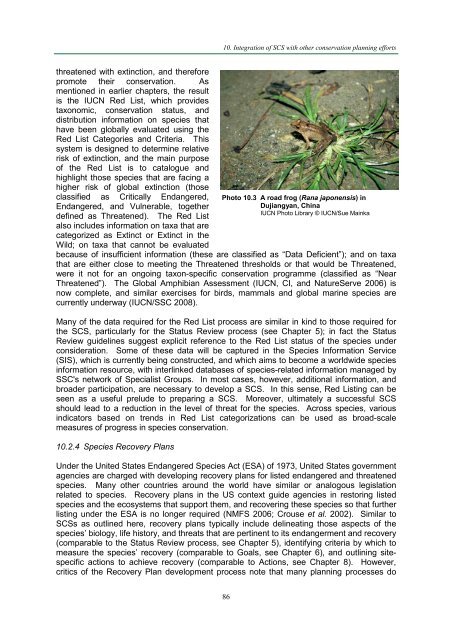Strategic Planning for Species Conservation: A Handbook - IUCN
Strategic Planning for Species Conservation: A Handbook - IUCN
Strategic Planning for Species Conservation: A Handbook - IUCN
You also want an ePaper? Increase the reach of your titles
YUMPU automatically turns print PDFs into web optimized ePapers that Google loves.
threatened with extinction, and there<strong>for</strong>e<br />
promote their conservation. As<br />
mentioned in earlier chapters, the result<br />
is the <strong>IUCN</strong> Red List, which provides<br />
taxonomic, conservation status, and<br />
distribution in<strong>for</strong>mation on species that<br />
have been globally evaluated using the<br />
Red List Categories and Criteria. This<br />
system is designed to determine relative<br />
risk of extinction, and the main purpose<br />
of the Red List is to catalogue and<br />
highlight those species that are facing a<br />
higher risk of global extinction (those<br />
classified as Critically Endangered,<br />
Endangered, and Vulnerable, together<br />
defined as Threatened). The Red List<br />
also includes in<strong>for</strong>mation on taxa that are<br />
categorized as Extinct or Extinct in the<br />
Wild; on taxa that cannot be evaluated<br />
10. Integration of SCS with other conservation planning ef<strong>for</strong>ts<br />
because of insufficient in<strong>for</strong>mation (these are classified as “Data Deficient”); and on taxa<br />
that are either close to meeting the Threatened thresholds or that would be Threatened,<br />
were it not <strong>for</strong> an ongoing taxon-specific conservation programme (classified as “Near<br />
Threatened”). The Global Amphibian Assessment (<strong>IUCN</strong>, CI, and NatureServe 2006) is<br />
now complete, and similar exercises <strong>for</strong> birds, mammals and global marine species are<br />
currently underway (<strong>IUCN</strong>/SSC 2008).<br />
Many of the data required <strong>for</strong> the Red List process are similar in kind to those required <strong>for</strong><br />
the SCS, particularly <strong>for</strong> the Status Review process (see Chapter 5); in fact the Status<br />
Review guidelines suggest explicit reference to the Red List status of the species under<br />
consideration. Some of these data will be captured in the <strong>Species</strong> In<strong>for</strong>mation Service<br />
(SIS), which is currently being constructed, and which aims to become a worldwide species<br />
in<strong>for</strong>mation resource, with interlinked databases of species-related in<strong>for</strong>mation managed by<br />
SSC's network of Specialist Groups. In most cases, however, additional in<strong>for</strong>mation, and<br />
broader participation, are necessary to develop a SCS. In this sense, Red Listing can be<br />
seen as a useful prelude to preparing a SCS. Moreover, ultimately a successful SCS<br />
should lead to a reduction in the level of threat <strong>for</strong> the species. Across species, various<br />
indicators based on trends in Red List categorizations can be used as broad-scale<br />
measures of progress in species conservation.<br />
10.2.4 <strong>Species</strong> Recovery Plans<br />
Photo 10.3 A road frog (Rana japonensis) in<br />
Dujiangyan, China<br />
<strong>IUCN</strong> Photo Library © <strong>IUCN</strong>/Sue Mainka<br />
Under the United States Endangered <strong>Species</strong> Act (ESA) of 1973, United States government<br />
agencies are charged with developing recovery plans <strong>for</strong> listed endangered and threatened<br />
species. Many other countries around the world have similar or analogous legislation<br />
related to species. Recovery plans in the US context guide agencies in restoring listed<br />
species and the ecosystems that support them, and recovering these species so that further<br />
listing under the ESA is no longer required (NMFS 2006; Crouse et al. 2002). Similar to<br />
SCSs as outlined here, recovery plans typically include delineating those aspects of the<br />
species’ biology, life history, and threats that are pertinent to its endangerment and recovery<br />
(comparable to the Status Review process, see Chapter 5), identifying criteria by which to<br />
measure the species’ recovery (comparable to Goals, see Chapter 6), and outlining sitespecific<br />
actions to achieve recovery (comparable to Actions, see Chapter 8). However,<br />
critics of the Recovery Plan development process note that many planning processes do<br />
86

















